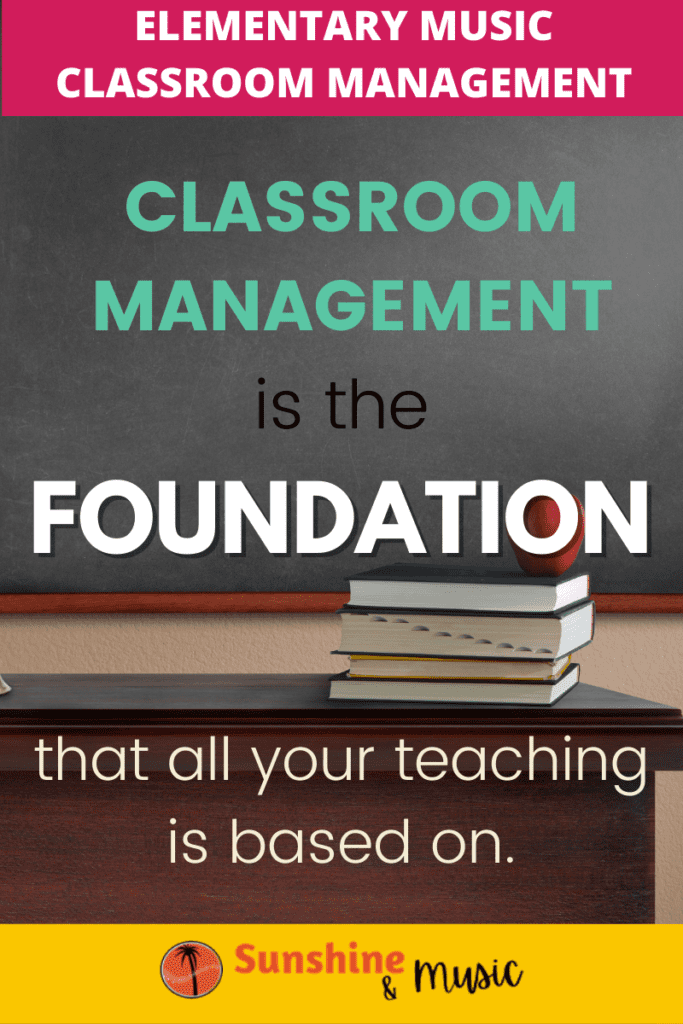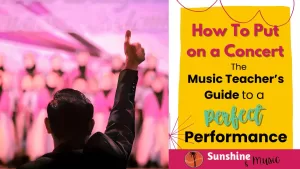Thinking of revamping your elementary music classroom management? Or maybe you are a new teacher, just thinking through your first classroom management plan for music class. Need some tips with That One Class that’s pushing all your buttons?
Everyone has had that moment where they just wish they could have one more tool in their toolbox to try with a class. Today I want to share with you some of my classroom management ideas for elementary music. These are the tips that work best for me, and hopefully help you too!
What is the purpose of classroom management?
Classroom management might seem secondary to teaching your curriculum or preparing for your next big show, but let me tell you now that if you don’t have classroom management, you don’t have anything.
Try teaching a lesson on something to a class full of students that are out of control, disrespectful or just way off task. It’s not going to happen.

Like the song says, “the house don’t fall if the bones are good.” You need the foundation of good classroom management or it will all come crashing down.
Classroom management is the most critical piece of the puzzle, and yet often is neglected in college methods courses. And while there is a degree of hands-on experience needed to truly master your own classroom management style, I feel there are a couple helpful tips that can set you well on your way to having the type of classroom environment you want (and need) to foster positive relationships and – oh yeah – learn.
Elementary Music Classroom Management Tips To Set Up Your Class For Success
Simple Elementary Music Classroom Rules
Make sure to keep your music room rules simple. I have even been at some schools where the special area teams all have the same few rules, so it is the same throughout the school, and I love this.
Another suggestion I have heard is to keep your rules and expectations positive. State what they SHOULD do instead of what they shouldn’t do.

Behavior Chart
I use a behavior chart, and classes can earn points for following all the rules for the day. I feel that this is key because it puts an element of teamwork. Everyone has to work to get the reward together. It adds so much more motivation than when it’s every man for themself.
Click here to learn more about my behavior chart system.

Teach Procedures
Don’t get mad at your students when you haven’t taught them the correct behaviors. Just as we teach them to read notes, sing on pitch and play a steady beat, we have to teach correct behaviors for music class.
As an example, at the beginning of the year I have a movement activity where we practice moving and stopping and I check that students are following our movement rules correctly. I give feedback and only after several repetitions and checking for understanding do I have students sit out if they aren’t moving safely. I have them observe the other students that are moving safely, and we have a VERY QUICK discussion about how they need to move to join back in.
Reteach procedures
Is your class sprinting across the room to enter your class? Sometimes we need to reteach. Kids forget things, and anytime you can make something a teachable moment instead of a punitive moment, it’s a win.

Focus on the positive
Is one kid just stealing the show with their antics? Some students crave attention, but choose to get it through misbehavior. See who you can compliment for their good behavior. Be specific. What exactly are they doing that you would like others to copy?
Example: “Look at Johnny! He is sitting so nicely with his hands and body in his own space. Can you all check and see if your body and hands are like Johnnys?”
Speak after class
Consider speaking to a student after class, or during a time when other students are working independently. That way you don’t waste class time and you can deal with the situation more privately. Sometimes students will act out more to save face when they are called out in class in front of their peers.
Also, sometimes there is something going on that you didn’t realize, and you can have much more in depth and productive conversations when you aren’t doing it in the middle of instructional time.
Use instruments as a motivator
Students LOVE using instruments. And for my kindergarteners, I used to wait until WAAAAY down into the year before we would play instruments. What a wasted opportunity! Now I try to pull out instruments as soon as the first day of kindergarten when possible.
I can almost guarantee you that you will have at least one students who is still getting used to this whole school things where they don’t alway get to do exactly what they want. So I might say – everyone who is sitting on their spot gets to play the egg shaker. Nine times out of ten, suddenly my resistant child (and the five ones rolling around in the background) are all sitting nicely on their spots.
Also, if the instrument is not being used correctly, it gets taken away. I have had to enforce this rule at every grade level at some point.
Give students choices
The more that students get to engage and make choices about what they are doing in class, the more chance there is that they will buy into what is happening and behave.
Have them decide on what movements you do with a song. Or have them pick between two activities to learn about your topic for the day. You could even have them pick a unit of study if you are feeling bold.
Read the room and make adjustments
Sometimes you will realize mid-lesson that the students are not with you. Maybe you are trying to teach something and they are just wiggling around. Stop and take a movement break, or try and figure out a way to incorporate movement into what you are teaching at that moment.
Or maybe you are doing a movement activity and the energy level is a) spiraling out of control or b) is non-existent. Maybe it is time to sit and do something low energy.
Read the energy level of your class and try to make your lesson fit with it.
Using music for classroom management

There are many ways that you can use music to signal certain behaviors in your room. For example, I have an electronic doorbell that plays “Eine Kleine Nachtmusik” when I press a button. This is our silent signal. My rule is when the song stops playing, they must be quiet and facing forward on their spot.
I save my voice by not asking for quiet over their talking, and it is a consistent signal that they immediately know.
You could also use music for entrance, exit, cleaning up, switching stations, or any number of other classroom behaviors.
Again, I cannot stress enough the importance of having non-verbal cues that save your voice. It is a precious commodity and shouldn’t be wasted.
I hope at least one of these ten tips gives you something new to consider for your elementary music classroom management.
More Classroom Management Ideas
Want more classroom management tips? Try checking out the Engaging Curiosity Blog. Marian has lots of great articles on techniques to use ion your classroom, such as the article 13 Transformative Classroom Management Techniques.
Interested in more helpful tips, lesson plan ideas and more? Sign up for my email list and get updates to your inbox once a month. Plus, get a free listening map and rhythm play along lesson when you sign up!
Other Posts You May Enjoy
Listening Maps for Music: The Ultimate How To Guide








3 Responses